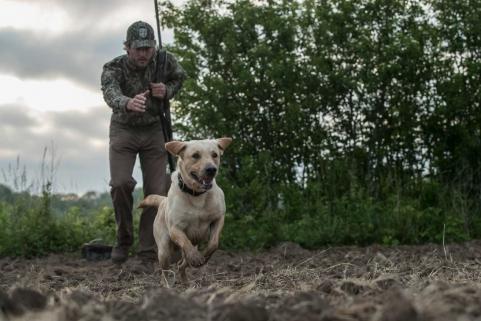Todd Amenrud | Originally published in GameKeepers: Farming for Wildlife Magazine. To subscribe, click here.
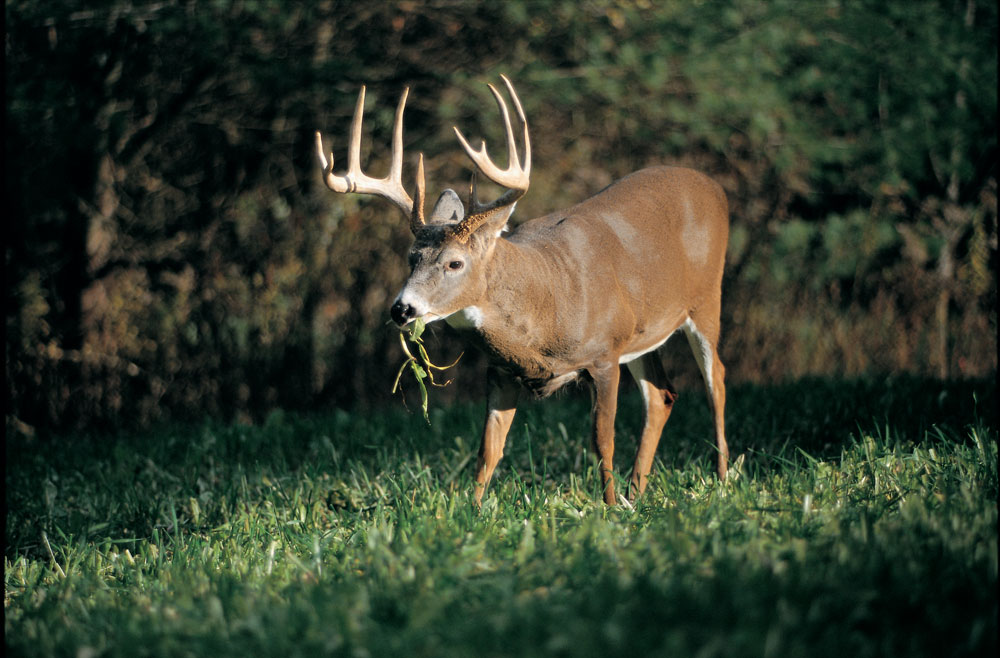
Throughout the country, traditional planting times for most crops coincides with when there is ample topsoil moisture available. The soil normally holds enough moisture during the spring from snowmelt in addition to those “April showers.” Then again, moisture returns during the late summer or fall when the sun’s angle to the earth subsides, allowing the moisture from any late summer thunderstorms to stay in the topsoil long enough to germinate the seeds and facilitate the new seedlings through lag phase and into plants our whitetails will relish. Some of the most attractive crops have been planted during the spring, but a majority of those “candy crops” are traditionally planted during the late summer (in the north) or fall (in the south). Picking a crop that is most attractive for when you want to hunt is a key to getting the most from your hunting plots.
Whitetail managers are lucky, in that many of the most attractive plantings end up also being some of the most nutritious. Timing and placement dictate when and how they will be used from north to south. Some plants can be used for specific missions while others cover a wide array of benefits.
Spring or Early Summer Food Plots for Whitetail Deer
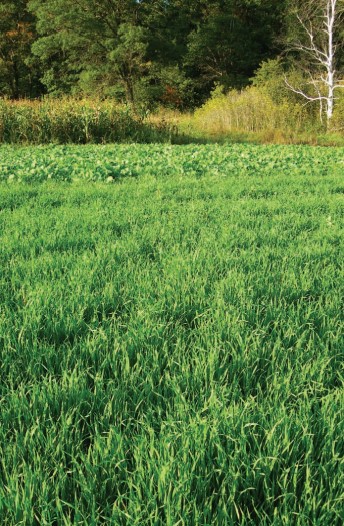
very attractive to whitetails during the hunting
season. Notice the variety in this hunting plot—
cereal grains, brassicas and corn in the
background.
Some of the most attractive crops are planted during the spring. For instance, for opening day attraction throughout the northern half of the United States and Canada you can’t beat a good clover blend. Perennials, such as red and white clovers, alfalfa, birds foot trefoil and chicory, are very attractive and very nutritious from the end of August on into October and even much later if warm temperatures pop up again. In the South, they are also very attractive but the time frame is only a bit later.
Corn is also planted during the spring or early summer and every hunter knows how attractive it can be to whitetails at times. When cold temperatures come they’ll be in the corn or brassicas. In fact, in the North, if you have deep snow those are basically your only two reliable food plot choices.
Annual legumes like soybeans, iron and clay peas or lablab are great summertime nutrition, but only the dried beans are really an option after a frost has occurred and your beans are dead and brown. If you concentrate on the crop for the earliest part of the bow season before a frost, they can hold some great attraction power. But these annual legumes are very vulnerable to cold temperatures. When planted for whitetails, most choose to plant these for the green leaf forage production for summertime nutrition, but in certain parts of the country dried soybeans left on the stalk can be a great late season magnet.
Variety is key to consistency, so available food plot acreage is a major concern. With small plots, since you can’t “do it all,” you must adopt a targeted approach. With little fields you’ll want your crop to be at the peak of its attraction when you plan on hunting it. If the plot allows the space for variety, by all means, I’m going to give it to them. If I have the space available I like to present an attractive, palatable food choice that will keep them coming from before opening day until the season ends or until the food runs out.
When designing a hunting plot, knowing when plants are favored and how they should be utilized is important. Following are a few choices that are planted during the late summer / fall planting season, when they are typically planted and when they are normally attractive to whitetails. Please keep in mind that different herds can respond to various types of plants uniquely. Because of deficiencies in native vegetation or certain plants missing from your overall food plot program, plants that would normally be palatable to whitetails during a certain stage of growth, or other plant types because weather events turn the plants to their most palatable stage, may be eaten at times other than their traditionally most attractive timeframe. Below are the norms for some of my favorite late summer/fall plantings.
Best Food Plot Crops for Deer in Late Summer/Fall
Winter Peas
These succulent annual legumes are like ice cream to whitetails. They are palatable right away after germination and typically devoured as fast as they grow. Because of this, you have a couple options.You can plant enough acreage to overwhelm the amount of mouths you have to feed or protect what you plant with electric fencing, P2 Plot Protector or some type of deer-proof barrier. Then, when you choose to “ring the dinner bell,” simply open the plot up to your herd. The other option is to plant smaller amounts and just understand that the crop will likely be eaten fast and furious, and just make sure you are there when the carnage is occurring.
Winter peas are planted as soon as early August in the far North to as late as early October in the South. They are normally planted a quarter of an inch deep at approximately 40 pounds per acre and will grow in all soil types as long as the site receives adequate rainfall. They like the sun, but can be grown in partial sun, to as little as six hours per day. Nutritional content will vary depending upon the stage of growth, but will average around 25 percent protein.
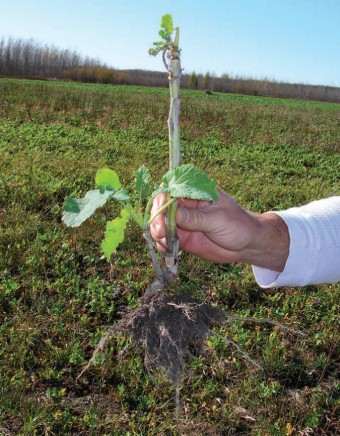
ideal whitetail food plot forage. This brassica
plant was browsed down to the stalk and with a
little rain it continues on pumping out new, lush
forage.
Winter peas are normally used for early season attraction and because of the poor yield in relation to other crops one of the best tactics is to fence off half your devoted acreage with P2 Plot Protector. The reason for protecting only half your crop is because it is much easier to protect one half if you give them the other portion. A hungry whitetail is hard to deter and if you cut them off completely they will almost certainly breach your defense if you’re only using one strand of P2. If you do protect the entire crop, keep a close eye on it and mend and bolster any breaches in the ribbon as soon as they are found. Once one whitetail finds the way in, it’s like opening the flood gate, so I usually use two off-set strands of P2 ribbon right from the get-go and I always leave a bit of the crop outside of the fenced off area to satisfy their appetite.
Cereal Grains
If someone told me I could only plant one thing for attraction during our gun season in Minnesota (early to mid-November) it would have to be Trophy Oats. Cereal grains like oats, wheat and triticale are relished by whitetails. They have high levels of carbohydrates and the energy these plants produce is utilized perfectly by the whitetails’ digestive system.
Cereal grains are easy to grow and will do well in soils that are a bit more acidic than other plant types, especially legumes. Cereal grains are palatable right away after germination for about their first 50 days of growth, then attraction power, palatability and nutritional content drop off the table. Thus, timing your planting is crucial for these succulent grasses if you wish them to be attractive when you plan to hunt. The idea is to plant them late enough so the 50-day period extends into the season as long as possible, but early enough so you attain a decent yield before cold temperatures shut down growth.
Traditionally, cereal grains are planted around mid-August in the North, September in the country’s mid-section and September and October throughout the South. It depends upon the specific cereal as to how deep it should be planted and the planting rate. It can vary from a quarter of an inch to half an inch deep for wheat or triticale to one to two inches deep for oats. Planting rates for cereal grains are heavier by weight than other plantings because of larger seed size. It also depends upon whether you’re broadcasting or using a drill. More seeds would be necessary when broadcasting to make up for the inconsistency in planting depth when compared to a precise drill.
Cereal grains will sometimes be planted during the spring in parts of the country. When managers do this they are either mowed periodically so fresh, more palatable growth happens shortly after, or they are left to go to seed and the seeds are disked in to germinate and produce a new crop. I prefer to simply plant them during the late summer or fall from seed. In my view, the fresh crop from seed is more attractive to whitetails than one simply being kept alive from mowing.
Cereal grains are easy to mix certain other plant types with to extend the palatability timeframe of a plot. Full Draw, Green Patch Plus, Last Bite and Outfitter’s Blend feature cereal grains mixed with brassicas, and/or legumes. Besides each having some uniquely exclusive cultivars, the big difference in these blends is the ratio of cereal grains in relation to the other plants.
Brassicas/Beets
Brassicas could simply be the best deer food God has ever created. They have the best protein content, most digestible nutrients and best yield out of any food plot crop that I know of. They are typically used for late season attraction or wintertime nutrition because of cold temperatures transforming the plant’s high levels of starch to sugar. But be prepared to experience the possibility of several scenarios if you’ve never planted them before.
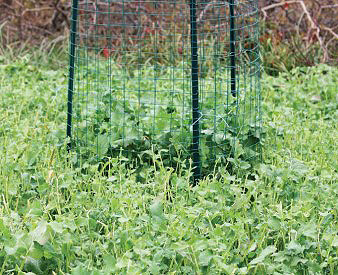
different conditions or in different areas. Most
often it will take cold temperatures to change the
plant’s high-levels of starch to sugar then they
become the most attractive. A browse cage will
teach you the potential of your plants (inside) and
what your herd is consuming (outside).
Deer may react differently to brassicas in different areas. Normally they don’t hit them hard until after a hard freeze or several frosts have occurred. However, the first time you plant them since you’re introducing a new plant to the area it may take you a while to battle a learning curve. The deer not hitting them right away has happened to me before. The first year I planted brassicas on my home property in Minnesota it wasn’t until after Christmas until they started eating them. Mother doe has taught her offspring to feed on various food sources throughout the year—and then her offspring teach their offspring, and so on—to feed on acorns this time of year, alfalfa this time of year, corn this time of year, etc. Now, you introduce a plant they have never seen before, that if they have tried it up until the starches convert to sugar it would have been bitter. Once they learn what this plant is, expect consumption to happen earlier each year. Now on my home property they will start to eat my brassicas as early as September.
They also react differently to this plant in various types of habitat. In a “big woods” scenario, where there isn’t a lot of agriculture around, they might eat it as fast as it comes out of the ground. For instance, on my Ontario property, they won’t let the brassicas mature, they eat them too fast. After the first cold temperatures in late August, they’ll eat them until they are gone.
In an agricultural area, typically they will leave this plant alone until the freeze. This, to me as a land manager, is good because it allows me to gain tonnage. With bigger plants I can feed more deer for a longer time. If your property is in an area that does not get cold enough temperatures to trigger a significant response, don’t devote vast acreage to brassicas until you see your herd turn-onto them. If you live in an area where you get cold temperatures during the hunting season I’ve never seen a better magnet for deer.
Brassicas include many different plant types that whitetails will devour—rape, canola, turnips and radishes are some of my favorites. My favorite blends are Maximum, Winter Bulbs & Sugar Beets and Deer-RADISH. Brassicas are also included with other plants in Perfect Plot, Premium Perennial (brassicas mixed with perennials), Full Draw, Green PatchPlus and Last Bite (brassicas blended with other annuals).
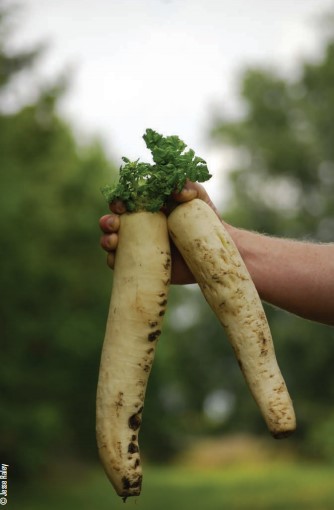
notorious for producing large root-bulbs;
however, not all brassicas produce root bulbs.
Most managers plant brassicas for their attractive
green forage. The yield and protein content is
much higher in the greens than the root bulbs,
but some food-plotters love to have the root bulbs
because whitetails love them and will dig deep for
them. This photo is of root bulbs from BioLogic’s
Deer-RADISH.
Beets can also be lumped in with brassicas, but they are not actually a brassica. The sugar beet that we use in Winter Bulbs & Sugar Beets extends the palatability duration of the mix significantly. Whitetails relish these just as well as brassicas.
These small tiny seeds create some amazing yield. Because the seeds are so small, a planting depth of a quarter of an inch or less is recommended. Ideally the seeds would be broadcasted on a firm seedbed and then rolled over with a cultipacker. They also produce excellent stands when planted through a drill. They can also be broadcasted on a prepared seedbed prior to a rain or frost seeded in certain areas. Heck, these seeds are so hardy I’ll have brassicas growing in the cracks of my driveway if I have an accidental spill.
Brassicas are very versatile when it comes to planting times. Traditionally, they are planted during the late summer or fall, but they can be planted earlier during the spring in the far north. It is not recommended to plant them earlier anywhere but the upper tier of the United States and Canada. Because of the longer growing season further south, the plants will likely bolt to flower and seed, something you DO NOT want. You don’t want your plants to use their energy to produce flowers and seeds—you want the plant’s energy to stay contained in the leaves to be transferred into antler and energy for your herd.
Even in northern latitudes it is recommended to plant during the late summer. Why battle the summer weed cycle for the possibility of a little more yield? The yield of a late summer/fall planting is so great anyhow, I wouldn’t suggest the gamble. The best planting times would be late July or early August in the North to September in the South. Even with late summer/fall planted brassicas yields from 12 to 20 tons per acre are common.
These seeds are normally planted at around nine pounds per acre and the plants will grow well in any soil type pending adequate soil moisture is present. They will work in a no-till preparation and in less than full sun (at least six hours per day). They can also do well in below neutral pH. In my view they are the ideal food plot crop.
I always preach versatility in a food plot program, but it is important to understand when and how each individual planting should be made use of. In my view, it is best to plant a combination of spring plantings and late summer plantings in the north. In the south most of your “menu” is planted during the late summer or fall, but a combination of annuals and perennials will also be your best bet under most conditions.















